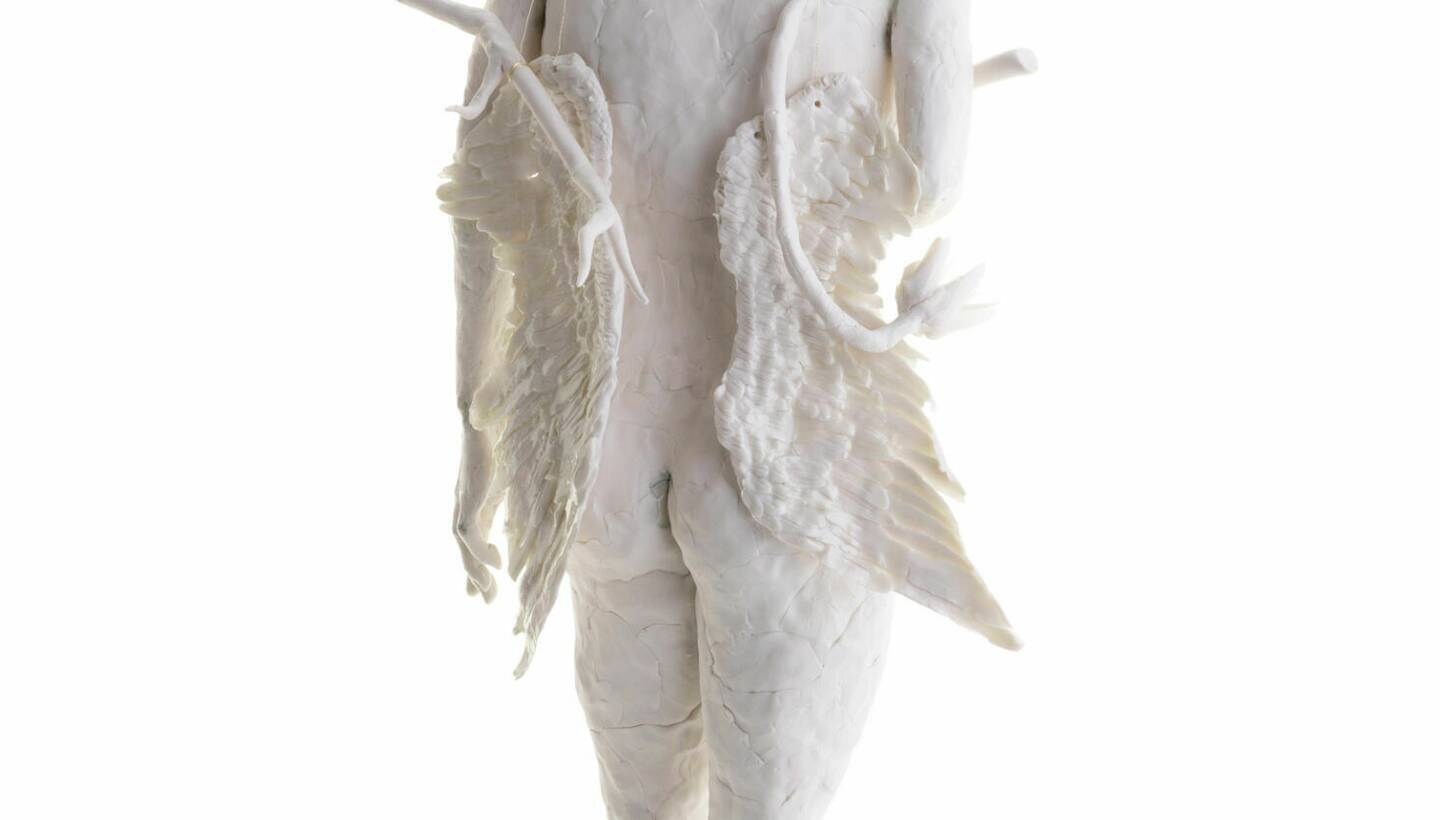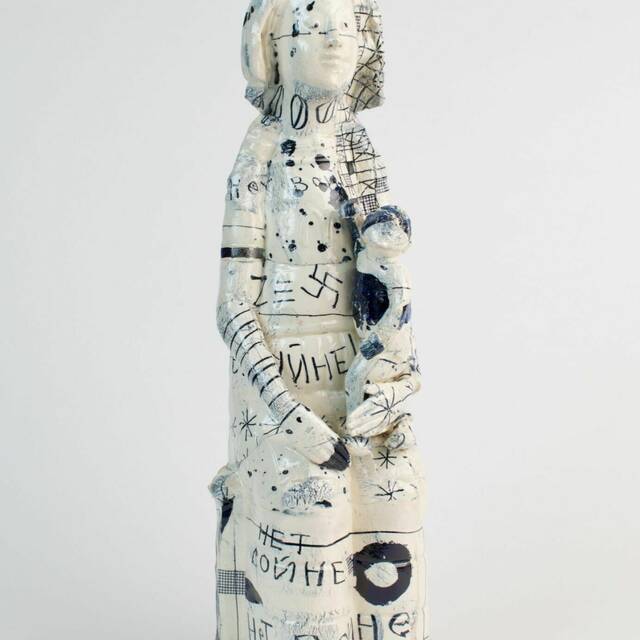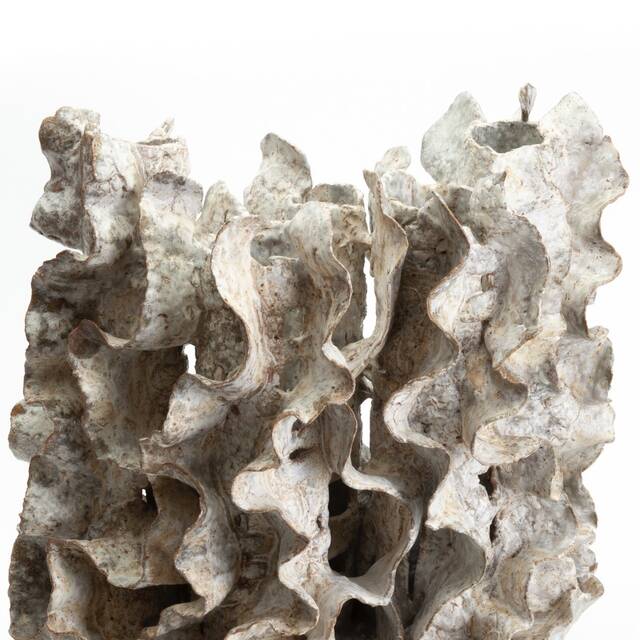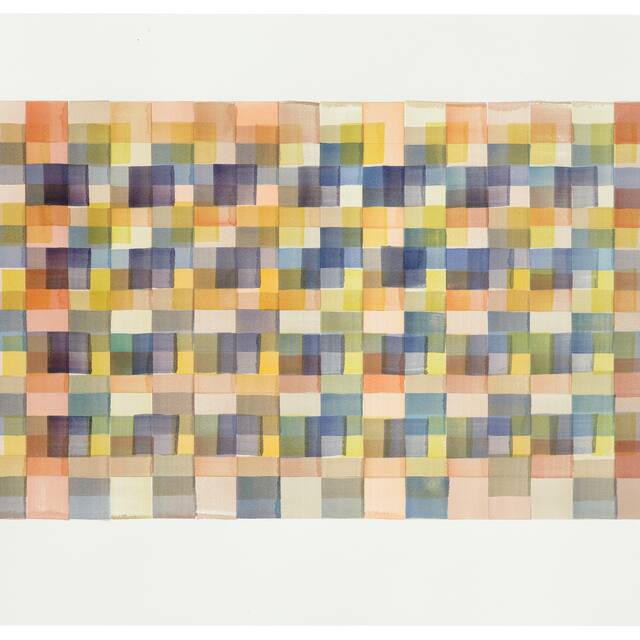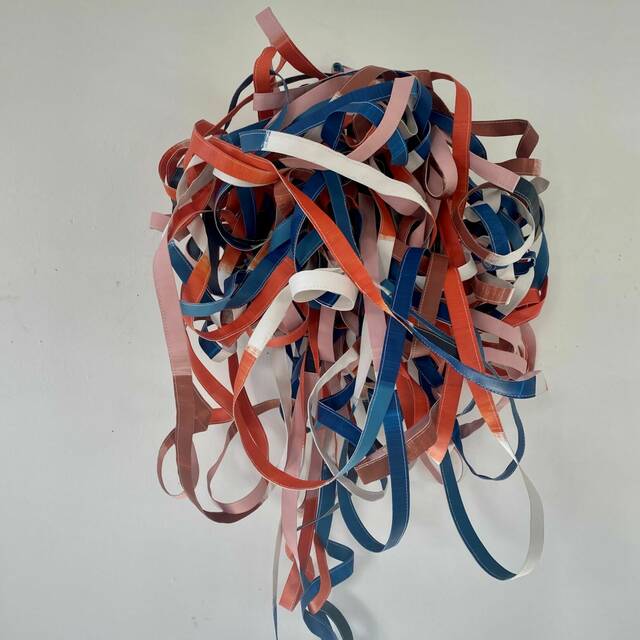A Deeper Understanding
Responding to Tobias and the Angel
Beverley Bell Hughes
Adam Buick
Claire Curneen
Philip Eglin
Cecile Johnson Soliz
Christine Mills + Dewi Tannatt Lloyd
Jacqui Poncelet
Our final Masterpiece Tour loan from the National Gallery in London is Tobias and the Angel from the Workshop of Andrea del Verrocchio. It was painted as an altarpiece around 1470-75. We explore well-being, reflection and contemplation in this exhibition of contemporary responses.

Introduction
Our final Masterpiece Tour loan from the National Gallery in London is Tobias and the Angel from the Workshop of Andrea del Verrocchio. It was painted as a devotional work around 1470-75.
I’ve loved this painting all my life. My dad made a linocut based on the work when I was a young child and so I remember seeing a postcard of it at home. When I was a student in the early 1990s I bought a book from the National Gallery shop simply because the painting was on the cover. It has always been one of my favourite paintings. Imagine how excited I was when the possibility of loaning it and bringing it to Newtown came about. As with the previous loans I wanted to bring together a group of works by contemporary artists that would create a dialogue with the masterpiece.
The title of the exhibition A Deeper Understanding comes from a track by Kate Bush which explores the impact of AI and computers on our human sense of being. The computer talks to the user, who becomes increasingly isolated in a virtual world, and says,
"Hello, I know that you've been feeling tired
I bring you love and deeper understanding
Hello, I know that you're unhappy
I bring you love and deeper understanding".
I had been thinking about how I wanted the exhibition to have a contemporary relevance, to connect the Renaissance masterpiece through to our time. It had been painted for a specific religious purpose: To act as a devotional painting for people in Florence in the Fifteenth Century. It would have been intended specifically as a focus for those praying for the blind, young merchants, healers and travellers.
The gallery is a space for reflection and contemplation. A pause in our day to day. I want visitors to be mindful of their sensory awareness, to take time, to listen, to see. This exhibition is contemplative in the same way that a chapel or a shrine or a temple or a space for meditation might be. A lot of our programme over the past two years has been about connecting people to the senses and materials, something we will continue to explore. The works in the exhibition are not to be touched so we have created a handling collection (by appointment) that allows you to feel some of the materials used by the artists. I want the viewer to have a sense of being in both inside a physical building but also aware of the natural world. I wanted to explore other approaches to religion and meditation, to consider how mindfulness, religious or otherwise, allows us time to reflect and focus.
Please sit and enjoy the National Gallery documentary and information about the painting in the space between the galleries. There’s also a space to make drawings of the painting and other works in the exhibition. We are happy to help you to enjoy the exhibition in way that works for you, so please ask at the desk if you want to access the handling collection, or have sound levels increased or reduced, or if you need assistance making your way around the galleries. Please note Gallery 2 is in darkness for the presentation of the Veneration Bell film. Gallery 1 features a film on the right hand side as you enter the gallery.
Tobias and the Angel
The story of Tobias and the Angel is explored directly in three works on loan for this exhibition. These representational images are from 1470, 1641 and 1774 and all show aspects of the story. The works are by the workshop of Verrocchio, Rembrandt and Claude Lorrain. You can see various elements of the story in each work. For example, the donkey in Rembrandt, the enormous fish in Claude and the dog in the Verrocchio. As the angel departs in Rembrandt's print you see his feet as he disappears through the window, this has a direct connection with Claire Curneen's suspended figure.
In Miss Garnet’s Angel (2000) Salley Vickers magically unfolds the story of Tobias’ redemption alongside the story of an older reserved English woman who spends a winter in Venice following the death of a long-term friend. We have other resources available on our website.
Christine Mills visited the work in the National Gallery and developed her piece in her Montgomeryshire studio. Dewi Tannatt Lloyd has documented her working style which reflects her harp playing. There is something of the tactile way in which the film shows her looking deeply at the painting as source material for developing other stories and narratives and connecting across time through to present.
Cecile Johnson Soliz connects to the details of the work, the sash, the sandal straps.
“Looking at, ‘Tobias and the Angel’, I am drawn to the intertwined hands and arms of both figures, the black cord that ties the cape of the Angel, the belts, sandals and boots, rolled up sleeves, the curly hair of each and the flowing movement and rhythm of the garments. I enjoy seeing how the Angel tied their cape and laced their sandals and Tobias - his belt and boots and how they threw their capes over their shoulders. These gestures are so familiar and make me feel an affinity with aspects of daily life in Verrocchio’s time.
My sculpture does not look like people, clothing or the landscape. I try to talk about people without representing them. I use processes and gestures like gathering up, bunching together and tying (and many more) as a way of talking about things we do – you can see these in Verrocchio’s painting too. I like keeping things close-to-hand as it’s a link to people and daily life. I try to find beauty in the simplest of things.”
Beverley Bell Hughes from North Wales works with clay in such an intuitive way. You get a sense of how her work has been formed. Her vessels are reminders of the seashore, and sand and the shapes that the wind forms on the beach. They’re like rock pools, with barnacles and strata. They fold and flow like the garments of Tobias. This connects through to the work of Adam Buick in Gallery 2.
“Each day is a journey of looking and experiencing nature’s changes. I work directly into the clay with no pre conceived ideas of how the work will look.
I work in a studio with no electric by choice. An intuitive process of making, and pinching clay. My work is made using flattened coils of clay into which other materials are added to change the surface texture, clays and sands. The work is pushed and pinched causing craters and holes.”
Claire Curneen’s work responds to the narrative of Christian, and more specifically, Catholic tradition.
'The Angels represent a grand presence. They are messengers, bringers of news, good or bad. They serve as a reminder of our mortality with a comforting presence. Terracotta is warm and has associations with the ground. It is ordinary and commonplace and therefore imparts a sense of belonging. This contrasts with the use of gold which carries meaning of high value and status. This work explores the idea of the importance of the ordinary existing alongside with the extraordinary' (Clare Curneen).
Philip Eglin on the other hand has a much more iconoclastic approach to religious subject matter, borrowing imagery from contemporary culture and applying them to forms that remind of medieval sculptures of the Madonna. The Virgin and Child piece has references to anti-war on it. There are so many interesting juxtapositions of the sacred and the profane. From McDonalds’ Golden Arches to the Tidy Britain symbol, references to the Russian invasion of Ukraine, a reminder of the innocence of children who are caught up in global conflict, and how things we take for granted can so easily be lost.
Jacqui Poncelet visited the painting in the National Gallery and has selected a series of paintings that connect with the colour in the work. We have also commissioned the wall piece which evokes the rhythm of the painting.
“When Steffan Jones-Hughes invited me to respond to Tobias and the Angel by Verocchio, I visited the National Gallery in London to see the painting in person. There are often qualities of scale, surface and pigment that cannot be found in any reproduction. I wanted to discover my response in relation to the original work.
There were many things that I was attracted to ____ I chose to focus on the interplay of colour and the ‘dancing’ relationship of the figures’ hands within the work.
For some years I have been a regular visitor to Wales; to the countryside around Ogmore Vale where my partner lives. When I first started to spend long periods of time there, I could not stop painting the colour relationships I found in the landscape. I saw these same hues again in Verocchio’s painting so I proposed showing some of these at Oriel Davies. Specifically, choosing paintings that might read something like colour samples, a palette from which to recreate Tobias and the Angel.
I then went on to create a new work, a wallpaper design from two wooden mannequin hands. One hand much larger than the other both tentatively reaching out to touch each other. While they are nothing like the hands Verocchio painted I hope they have a similar tenderness.”
Sydney Curnow Vosper’s watercolour shows the same sense of touch as we see elsewhere in the exhibition. The image shows two women, one gently guiding the other, the pose very similar to the Verrocchio.
Adam Buick’s film of the Veneration Bell had been shown at Ruthin Craft Centre and I remembered how beautiful it was. Veneration implies great respect, reverence for something and in the film I’m immersed in the awe of nature and the cathedral of the cave. There is something meditative about the rhythm of the sea as it is constantly moving , constantly changing , but connected to the gravitational pull of the moon. The sea is punctuated by a sonorous bell ringing, connecting the film at the very back of the space with the bell at the entrance.
Educational Resources:
National Gallery Resources
Pie Corbett story: Tobias and the Angel | Teachers and schools | National Gallery, London
Out of Art case study | Teachers and schools | National Gallery, London
https://www.nationalgallery.org.uk/media/vjkjctmp/notes_verrochio-tobias_rev.pdf
Christine Mills (with thanks to Ruthin Craft Centre)
Christine Mills Film English
https://vimeo.com/719871077/2e94450acd
Christine Mills Worksheet English
https://www.dropbox.com/s/byuce225hrcvrsi/Christine_Mills_Worksheet_English.pdf?dl=0
Christine Mills Film Cymraeg
https://vimeo.com/719860138/63f4fcea7d
Christine Mills Worksheet Cymraeg
https://www.dropbox.com/s/4w3y0g2dh6znkrb/Christine_Mills_Gweithdy_Cymraeg.pdf?dl=0
Sketchbook Portffolio Toolkit Document English
https://tinyurl.com/5x36ddev
Sketchbook Portffolio Toolkit Document Cymraeg
Related Events
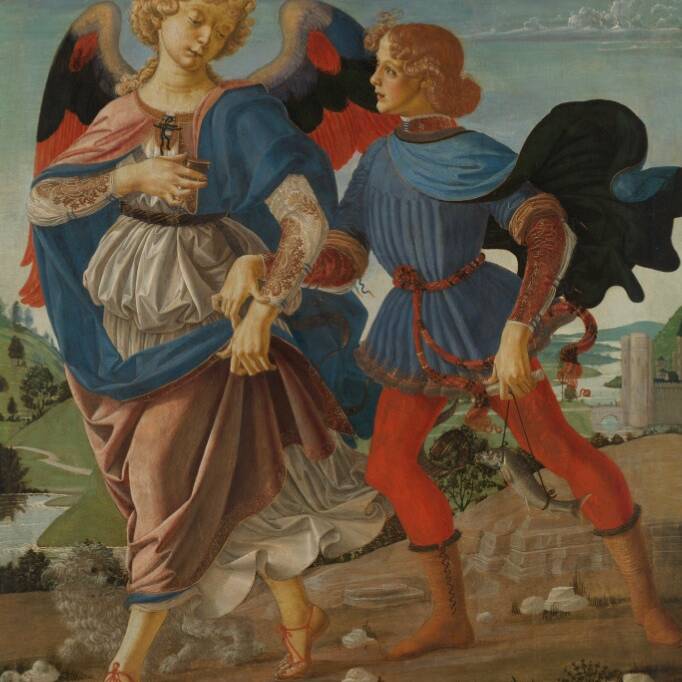
The National Gallery Masterpiece Tour: TOBIAS AND THE ANGEL
Verrocchio
02.12.22 - 05.03.23
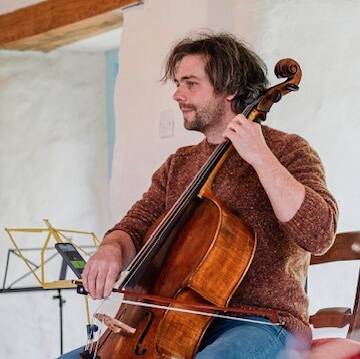
Daniel Davies: Cellist
Music in the gallery: part of Warm Welcome
01.02.23 - 01.02.23
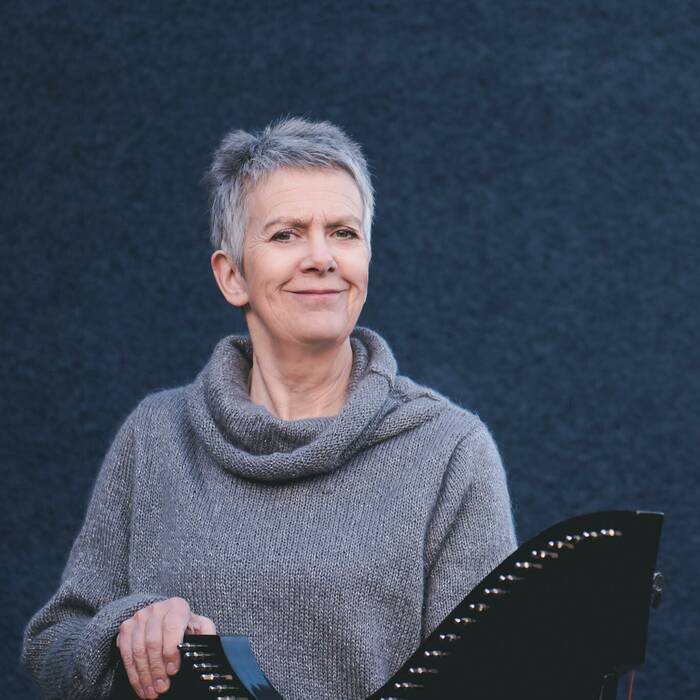
Delyth Jenkins: Harpist
Music in the Gallery: Part of Warm Welcome
10.02.23 - 10.02.23
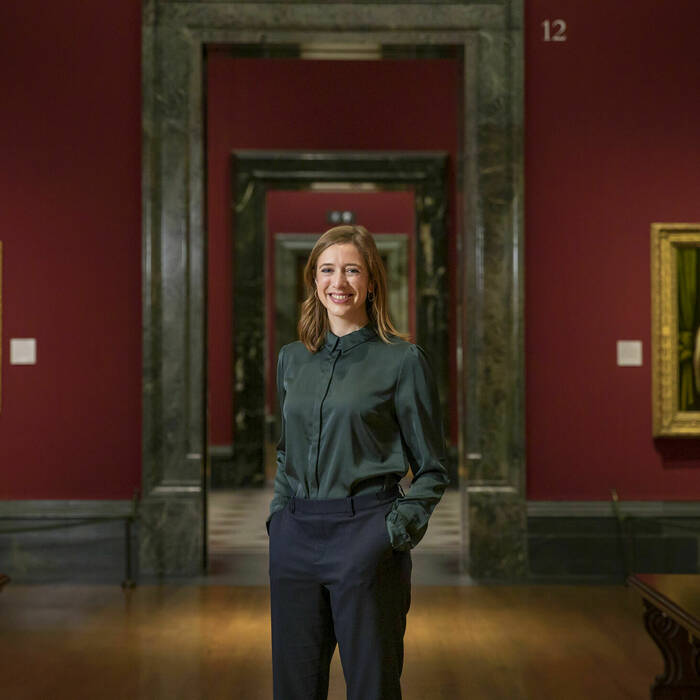
Gallery Talk
National Gallery Masterpiece Tour: Andrea del Verrocchio’s Tobias and the Angel
17.02.23 - 17.02.23
